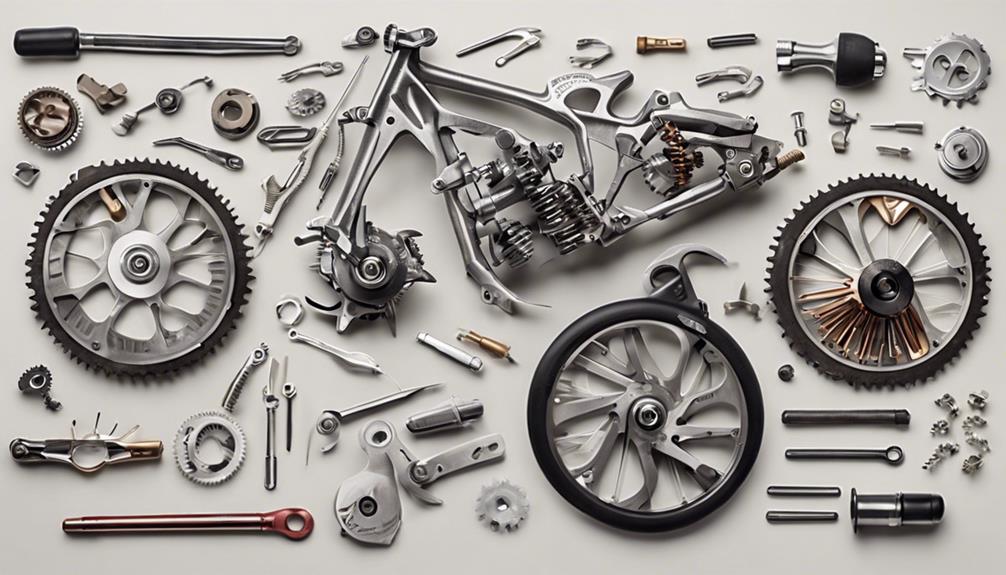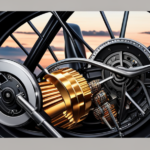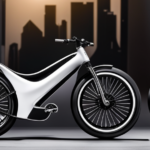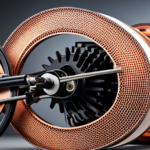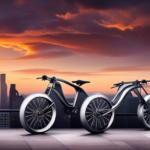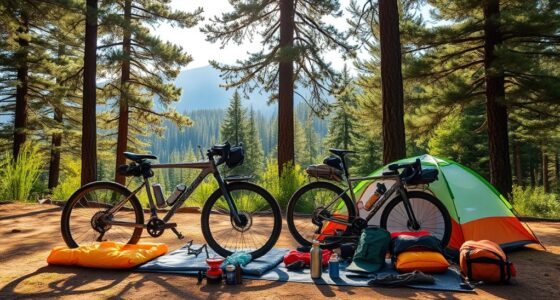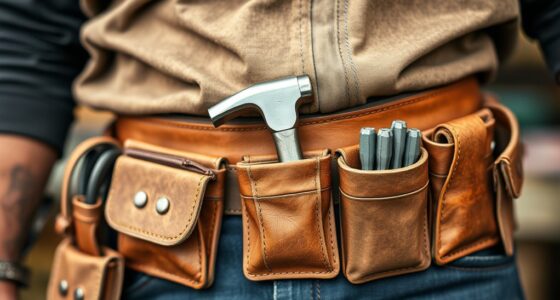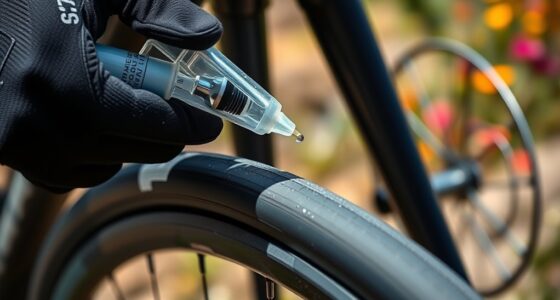When it comes to upgrading your bicycle with a motor, it's crucial to navigate through a sea of options to find the perfect fit.
As we explore the realm of electric bike motors, we uncover a plethora of considerations that can significantly impact your riding experience. From torque and power to motor placement and battery systems, each element plays a vital role in crafting the ideal biking companion.
Join us as we unravel the intricacies of selecting the best motor for your bicycles, ensuring a seamless and efficient journey on two wheels.
Key Takeaways
- Choose between mid-drive or hub motors based on terrain and design preferences.
- Consider motor power, torque, and placement for optimal performance.
- Higher wattage motors tackle steep inclines and demanding trails effectively.
- Select motor brands like Bosch, Shimano, Yamaha, or Mahle for quality and features.
Types of Bicycle Motors
When considering the types of bicycle motors available, mid-drive motors and hub motors stand out as the primary options for electric bike enthusiasts. Mid-drive motors, such as the Shimano STEPS or Fazua Ride systems, are strategically placed near the bike's bottom bracket, ensuring efficient power transfer and optimal weight distribution. These motors are favored for mountain bikes, where handling rough terrain and gaining improved traction are paramount.
On the other hand, hub motors, whether located in the front or rear wheel, offer a simpler design, requiring less maintenance and providing a stealthier appearance. Commonly used in electric road bikes, hub motors offer a sleek aesthetic and easy installation. While mid-drive motors excel in balance and control, hub motors are versatile for various electric bike types.
Understanding the differences in torque output, power output, and range can help cyclists choose the best motor to suit their biking needs.
Key Motor Features to Consider

Considering key motor features is essential for selecting the most suitable motor for an electric bike. When evaluating motors, two critical aspects to focus on are power and torque. Power, measured in watts, dictates the motor's overall performance, while torque, in Newton meters, determines the force applied to move the bike forward efficiently.
RPM, or revolutions per minute, influences speed, with higher RPM enhancing performance. Additionally, the placement of the motor – whether front-hub, mid-mounted, or rear-hub – plays a crucial role in the bike's handling and performance.
Understanding these features is essential for optimizing the electric bike system based on your preferences and riding conditions. Furthermore, different e-bike classes have specific regulations concerning motor power and speed, influencing where the bike can legally be ridden.
Electric Bike Motor Power Ratings

Electric bike motor power ratings, measured in watts (W), are crucial indicators of the motor's strength and performance capabilities. Most electric bike motors fall within the 250-750W range, providing varying levels of power output to assist riders based on their riding needs. Higher wattage motors generally offer more torque, making them suitable for challenging terrain such as mountain riding.
Understanding the power rating of the motor is essential for selecting a system that aligns with your preferences and requirements. For instance, models like the Performance Line CX can exceed 1,000W, offering increased speed and acceleration for riders seeking a more robust riding experience. When tackling steep inclines or demanding trails, opting for a motor with higher wattage can significantly enhance the rider's ability to conquer such obstacles with ease.
It's important to consider the power output of the electric bike motor to ensure it can efficiently assist you in navigating various terrains and meeting your riding expectations.
Comparison of Top E-Bike Motor Brands

To explore the Comparison of Top E-Bike Motor Brands, we'll analyze key features and performance capabilities offered by leading manufacturers in the industry.
Bosch eBike Systems stands out with motors like the Active Line for urban mobility, Cargo Line for heavier loads, and the Performance Line offering various torque options.
Shimano STEPS platform caters to different needs with models like E6100 for hybrid bikes, E5000 for urban bikes, and E7000 for diverse e-bike applications.
Yamaha impresses with motors like the PW-XM and PWseries S2, known for high torque and lightweight designs.
Mahle X20 boasts adaptive outputs, quick charging, and versatility for various bike types.
TQ HPR50 offers a compact, powerful mid-motor with lightweight battery options and various control features.
When seeking a good, powerful motor system for your electric bike, considering brands like Bosch, Shimano, Yamaha, Mahle, and TQ can ensure a satisfying ride whether on a cargo bike or using a range extender.
Motor Placement and Performance

Mid-mounted motors, located in the bottom bracket area, are preferred for their versatility across various electric bike types. These motors offer a balanced distribution of weight, which enhances the overall handling of the bike. On the other hand, rear-hub motors are popular on electric mountain bikes for their ability to assist with steep climbs while maintaining traction on rough terrain. When considering motor placement, it is essential to factor in the total system weight to ensure optimal performance and efficiency. Front-hub motors are commonly found on commuting and folding electric bikes, providing an additional boost to pedal power without compromising the sleek appearance of the bike.
—
| Motor Placement | Performance |
|---|---|
| Mid-mounted motors | Versatile across various electric bike types |
| Rear-hub motors | Ideal for electric mountain bikes and rough terrains |
| Front-hub motors | Commonly seen on commuting and folding electric bikes |
| Battery Placement | Options to mount on down tube, seat tube, integrate, or under the luggage rack |
Frequently Asked Questions
What Is the Best Motor to Put on a Bicycle?
For the best motor on a bicycle, we recommend considering factors like intended use, power requirements, and budget. Mid-drive motors are efficient and powerful for mountain and cargo bikes, whereas hub motors offer a sleek appearance.
Which Ebike Motor Is the Most Reliable?
We've scoured the market for the most reliable ebike motor, and the winner is clear – the TQ HPR50. Its compact powerhouse design, lightweight battery, and customizable features make it a top choice for any rider.
Which Is Better Hub Motor or Mid-Drive Motor?
When comparing hub motors and mid-drive motors, hub motors are simpler and cheaper, while mid-drive motors offer better performance and efficiency with their central placement. Ultimately, the choice depends on individual needs and preferences.
How Powerful of an Ebike Motor Do I Need?
We need a powerful ebike motor to conquer the toughest trails and carry heavy loads effortlessly. Consider terrain, desired speed, and torque needs. Opt for 500+ watts for challenging rides. Don't settle for less; let's power up!
Conclusion
After researching and analyzing various electric bike motor options, we've concluded that choosing the right motor is crucial for optimizing your biking experience.
Just like a well-oiled engine powers a vehicle, a high-quality motor can propel your bicycle to new heights. With the right motor in place, you can conquer any terrain with ease and efficiency, making your rides more enjoyable and fulfilling.
Choose wisely, and let your motor drive you towards endless adventures.
